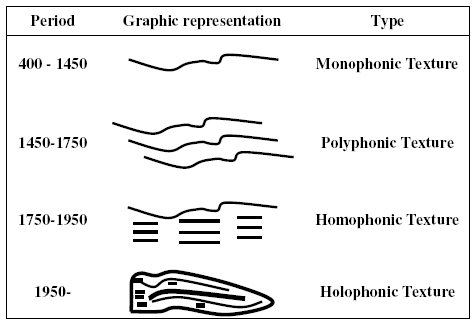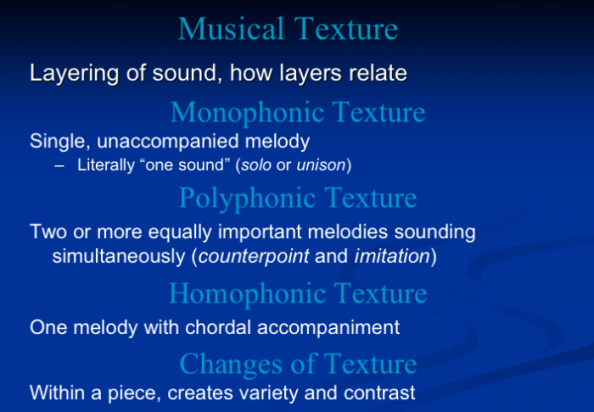Your Types of musical texture images are available. Types of musical texture are a topic that is being searched for and liked by netizens now. You can Find and Download the Types of musical texture files here. Download all free images.
If you’re searching for types of musical texture images information linked to the types of musical texture topic, you have come to the right blog. Our website always gives you suggestions for seeing the highest quality video and image content, please kindly search and find more informative video articles and graphics that match your interests.
Types Of Musical Texture. There are four music textures that you need to understand. 63 - Musical Style 1440. There is no harmonious accompaniment and no other music is made except melodies. I had mentioned a while back that I was going to write a series of posts on the differences between different types of music.
 Musical Texture Learn About Different Music Textures From musictheoryacademy.com
Musical Texture Learn About Different Music Textures From musictheoryacademy.com
62 - Musical Form 3411. 3-D art such as sculpture and architectural structures are tactile in. 61 - Musical Texture 1348. 2 types of polyphonic. Monophonic texture includes only a single melody line. There is one particular difference that I find particularly interesting.
The Different Types of Texture.
Musical Texture refers to how different layers of a piece of music are combined to produce the overall sound. The Two Types of Texture Tactile and Visual Tactile texture is the real thing. 63 - Musical Style 1440. When we talk about texture we refer to how many instruments or voices are performing concurrently and how their collective timbres density and pitch range all align. A texture may be monophonic single melodic line polyphonic two or more melodic lines and homophonic the main melody accompanied by chords. 2 types of polyphonic.
 Source: musictheoryacademy.com
Source: musictheoryacademy.com
The amount of parts playing simultaneously. Usually the development section is thicker in musical texture and full in unstable harmonic structure. The image above shows four images that texture may conjure in your mind the smooth sands of a vast desert the rough brick wall in a decrepit city building the rolling waves of the ocean or the repeating patterns of plant life. Texture in music can be described using several terms but the. The development section features a completely new theme.
 Source: courses.lumenlearning.com
Source: courses.lumenlearning.com
The four common texture types are monophonic. The result of the number and character of musical lines in a piece. The development section features a completely new theme. 3 types of texture. The word monophonic is derived from the Greek word mono which means and.
 Source: hellomusictheory.com
Source: hellomusictheory.com
Musical texture refers to the number and type of layers used in a composition and how these layers are related. The amount of parts playing simultaneously. The main types of texture in music are monophony. Musical texture refers to the number and type of layers used in a composition and how these layers are related. There is no harmonious accompaniment and no other music is made except melodies.
 Source: juliajooya.com
Source: juliajooya.com
In other words texture in music is the relationship between the layers of sound or lines or voices. The result of the number and character of musical lines in a piece. Finally Ill talk you through the four families of musical instrumentsbrasses percussions strings and woodwinds—and the various musical textures forms and styles that they can create. The Two Types of Texture Tactile and Visual Tactile texture is the real thing. In music texture is how the tempo melodic and harmonic materials are combined in a musical composition determining the overall quality of the sound in a piece.
 Source: juliajooya.com
Source: juliajooya.com
It is actually the way to describe how a piece of music or sound is organized. It consists of a melody or song played or sung by a single person or in unison. The development section features a completely new theme. These terms are monophonic homophonic and polyphonic which well take a look at next. Some people will use the term layers of sound interchangeably with Texture.
 Source: musicandmeaning.net
Source: musicandmeaning.net
The Two Types of Texture Tactile and Visual Tactile texture is the real thing. Musical Texture refers to how different layers of a piece of music are combined to produce the overall sound. A texture may be monophonic single melodic line polyphonic two or more melodic lines and homophonic the main melody accompanied by chords. The Two Types of Texture Tactile and Visual Tactile texture is the real thing. A wide range of choices for you to choose from.
 Source: musictheoryacademy.com
Source: musictheoryacademy.com
Texture is generally described as monophonic single line heterophonic elaboration on a single line homophonic single line with accompaniment or polyphonic many voiced. 62 - Musical Form 3411. In other words texture in music is the relationship between the layers of sound or lines or voices. The main types of texture in music are monophony. The result of the number and character of musical lines in a piece.
 Source: slideplayer.com
Source: slideplayer.com
Types of Musical Textures. The timbre of the instruments or voices playing these parts. There is one particular difference that I find particularly interesting. The four common texture types are monophonic polyphonic homophonic and heterophonic. Texture is the way harmonies melodies rhythms and timbres sound qualities such as different instrument sounds relate to create the overall effect of a piece of music.
 Source: juliajooya.com
Source: juliajooya.com
The four common texture types are monophonic. Monophonic texture is the simplest of the three main types of texture in music. Texture and Texture Types. There is no harmonious accompaniment and no other music is made except melodies. Understanding texture makes harmonic analysis much easier.
 Source: music.stackexchange.com
Source: music.stackexchange.com
The texture of a piece can change because of the following factors. 62 - Musical Form 3411. Finally Ill talk you through the four families of musical instrumentsbrasses percussions strings and woodwinds—and the various musical textures forms and styles that they can create. I had mentioned a while back that I was going to write a series of posts on the differences between different types of music. Texture in music refers to the number of musical lines and their density in a piece of music.
 Source: slideplayer.com
Source: slideplayer.com
I had mentioned a while back that I was going to write a series of posts on the differences between different types of music. Consists only of a single melody without. There is no harmonious accompaniment and no other music is made except melodies. The word monophonic is derived from the Greek word mono which means and. There is one particular difference that I find particularly interesting.
 Source: scotdir.com
Source: scotdir.com
Harmonic analysis is the analysis of chords in musical context. Texture is the way harmonies melodies rhythms and timbres sound qualities such as different instrument sounds relate to create the overall effect of a piece of music. Monophonic texture includes only a single melody line. The development section features a completely new theme. 3-D art such as sculpture and architectural structures are tactile in.
 Source: musictheoryacademy.com
Source: musictheoryacademy.com
The four common texture types are monophonic. The image above shows four images that texture may conjure in your mind the smooth sands of a vast desert the rough brick wall in a decrepit city building the rolling waves of the ocean or the repeating patterns of plant life. A wide range of choices for you to choose from. The main types of texture in music are monophony. The Two Types of Texture Tactile and Visual Tactile texture is the real thing.
 Source: youtube.com
Source: youtube.com
The development section features a completely new theme. Musical Texture refers to how different layers of a piece of music are combined to produce the overall sound. There are four music textures that you need to understand. The timbre of the instruments or voices playing these parts. The amount of parts playing simultaneously.
 Source: musictechmusician.weebly.com
Source: musictechmusician.weebly.com
The texture is often described in regard to the density or thickness and range or width between lowest and highest pitches in relative terms as well as more specifically distinguished according to the number of. The development section features a completely new theme. In this lesson we will look at definitions and explanations for each musical texture in turn. Monophonic texture includes only a single melody line. The main types of texture in music are monophony.

A texture may be monophonic single melodic line polyphonic two or more melodic lines and homophonic the main melody accompanied by chords. The Two Types of Texture Tactile and Visual Tactile texture is the real thing. Just like there are various textures of clothes hair or food there are also different textures in music. How often is one type of music more enjoyable than the other. 2 types of polyphonic.
 Source: musictheoryacademy.com
Source: musictheoryacademy.com
The timbre of the instruments or voices playing these parts. Finally Ill talk you through the four families of musical instrumentsbrasses percussions strings and woodwinds—and the various musical textures forms and styles that they can create. It consists of a melody or song played or sung by a single person or in unison. What images pop into your heard when you hear the word texture. Usually the development section is thicker in musical texture and full in unstable harmonic structure.
 Source: cnx.org
Source: cnx.org
Find the formats youre looking for Types Of Musical Texture here. I had mentioned a while back that I was going to write a series of posts on the differences between different types of music. The Two Types of Texture Tactile and Visual Tactile texture is the real thing. Texture in music refers to the number of musical lines and their density in a piece of music. The texture is often described in regard to the density or thickness and range or width between lowest and highest pitches in relative terms as well as more specifically distinguished according to the number of.
This site is an open community for users to share their favorite wallpapers on the internet, all images or pictures in this website are for personal wallpaper use only, it is stricly prohibited to use this wallpaper for commercial purposes, if you are the author and find this image is shared without your permission, please kindly raise a DMCA report to Us.
If you find this site serviceableness, please support us by sharing this posts to your favorite social media accounts like Facebook, Instagram and so on or you can also save this blog page with the title types of musical texture by using Ctrl + D for devices a laptop with a Windows operating system or Command + D for laptops with an Apple operating system. If you use a smartphone, you can also use the drawer menu of the browser you are using. Whether it’s a Windows, Mac, iOS or Android operating system, you will still be able to bookmark this website.






